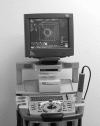Transrectal ultrasound, manometry, and pudendal nerve terminal latency studies in the evaluation of sphincter injuries
- PMID: 20011414
- PMCID: PMC2780206
- DOI: 10.1055/s-2008-1080995
Transrectal ultrasound, manometry, and pudendal nerve terminal latency studies in the evaluation of sphincter injuries
Abstract
Fecal incontinence may be due to postpartum anal sphincter injuries or neurological damage even in the absence of obvious perineal trauma. Anal physiologic testing with transrectal ultrasound, manometry, and pudendal nerve terminal latency studies help to identify those patients with anal sphincter injuries who might benefit from anal sphincter repair. In this article, the authors discuss the specific tests that are available and how to interpret them.
Keywords: Anal sphincter injuries; anal physiology testing; fecal incontinence.
Figures















Similar articles
-
Delayed pudendal nerve conduction and endosonographic appearance of the anal sphincter complex.Dis Colon Rectum. 2000 Dec;43(12):1689-94. doi: 10.1007/BF02236851. Dis Colon Rectum. 2000. PMID: 11156452
-
Pudendal nerve damage increases the risk of fecal incontinence in women with anal sphincter rupture after childbirth.Acta Obstet Gynecol Scand. 1995 Jul;74(6):434-40. doi: 10.3109/00016349509024405. Acta Obstet Gynecol Scand. 1995. PMID: 7604686 Clinical Trial.
-
The utility of pudendal nerve terminal motor latencies in idiopathic incontinence.Dis Colon Rectum. 2006 Jun;49(6):852-7. doi: 10.1007/s10350-006-0529-y. Dis Colon Rectum. 2006. PMID: 16598403
-
Fecal incontinence. Studies on physiology, pathophysiology and surgical treatment.Dan Med Bull. 2003 Aug;50(3):262-82. Dan Med Bull. 2003. PMID: 13677243 Review.
-
[Postpartum fecal incontinence. State of the problem].Khirurgiia (Mosk). 2022;(6):127-132. doi: 10.17116/hirurgia2022061127. Khirurgiia (Mosk). 2022. PMID: 35658144 Review. Russian.
Cited by
-
Establishing a peripartum perineal trauma clinic: a narrative review.Int Urogynecol J. 2021 Jul;32(7):1653-1662. doi: 10.1007/s00192-020-04631-8. Epub 2021 Jan 5. Int Urogynecol J. 2021. PMID: 33399903 Review.
-
Anal Sphincter Defect and Fecal Incontinence.JPGN Rep. 2022 Oct 20;3(4):e254. doi: 10.1097/PG9.0000000000000254. eCollection 2022 Nov. JPGN Rep. 2022. PMID: 37168467 Free PMC article.
-
Advances in motility testing--current and novel approaches.Nat Rev Gastroenterol Hepatol. 2013 Aug;10(8):463-72. doi: 10.1038/nrgastro.2013.80. Epub 2013 May 7. Nat Rev Gastroenterol Hepatol. 2013. PMID: 23648939 Review.
-
Dynamic transperineal ultrasonography correlates with prolonged pudendal nerve latency in female with fecal incontinence.Updates Surg. 2020 Dec;72(4):1187-1194. doi: 10.1007/s13304-020-00838-y. Epub 2020 Jun 28. Updates Surg. 2020. PMID: 32596803
-
An Evidence-Based Approach to the Evaluation, Diagnostic Assessment and Treatment of Fecal Incontinence in Women.Curr Obstet Gynecol Rep. 2014 Sep;3(3):155-164. doi: 10.1007/s13669-014-0085-8. Curr Obstet Gynecol Rep. 2014. PMID: 25505643 Free PMC article.
References
-
- Johanson J F, Lafferty J. Epidemiology of fecal incontinence: the silent affliction. Am J Gastroenterol. 1996;91:33–36. - PubMed
-
- Sultan A H, Kamm M A, Hudson C N, et al. Anal sphincter disruption during vaginal delivery. N Engl J Med. 1993;329:1956–1957. - PubMed
-
- Donnelly V, O'Connell P R, O'Herlihy C. The influence of oestrogen replacement on faecal incontinence in post menopausal women. Br J Obstet Gynaecol. 1997;104:311–315. - PubMed
-
- Nichols C M, Ramakrishnan V, Gill E J, Hurt W G. Anal incontinence in women with and those without pelvic floor disorders. Obstet Gynecol. 2005;106(6):1266–1271. - PubMed
-
- Willis S, Faridi A, Schelzig S, et al. Childbirth and incontinence: a prospective study on anal sphincter morphology and function before and early after vaginal delivery. Arch Surg. 2002;387:101–107. - PubMed

